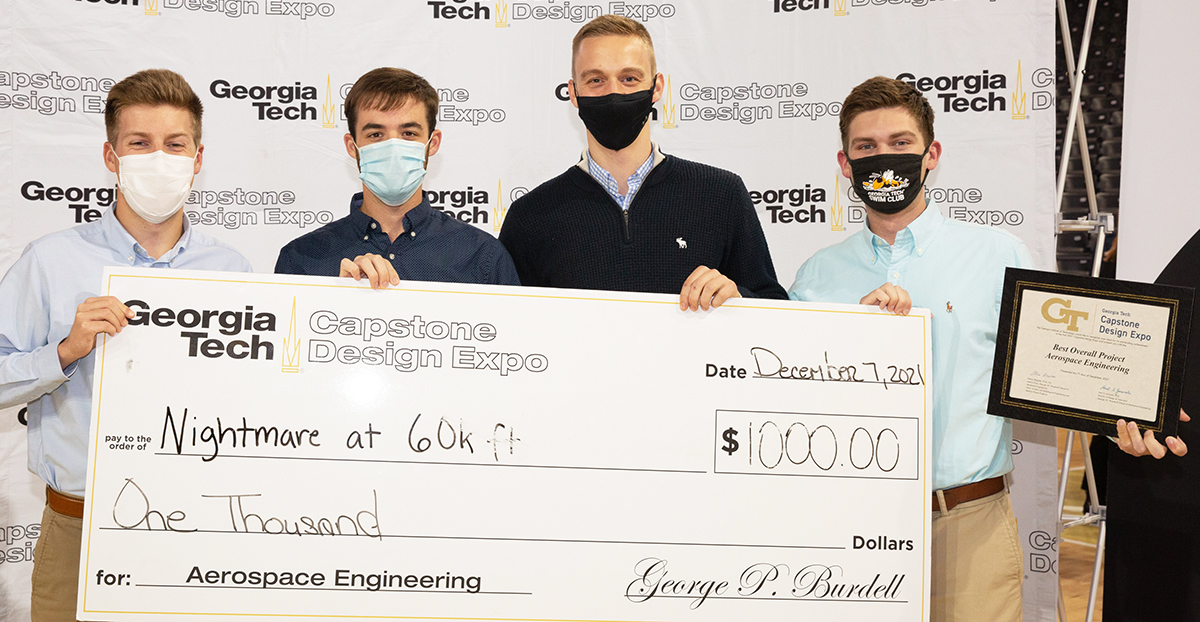
Team Nightmare Turns into a Dream Win: from left, Jonathan DeLozier, Josh McElveen, Paul Trevidic, Christopher Languell; (not pictured) Cody Brown.
Team Nightmare at 60k Feet (Team Nightmare) won the top aerospace engineering project during Georgia Tech’s Fall 2021 Capstone Design Expo, held in McCamish Pavilion on December 7. The Expo returned to McCamish Pavilion for the first time since the fall of 2019, with more than 500 students broken into 118 teams from seven school and three colleges participating.
The AE School hosted 10 teams each tasked with solving a complex aerospace engineering challenge. Student teams chose between a vertical lift, space, or a fixed-wing course to determine their semester-long senior project.
Team Nightmare took on the fixed-wing challenge of designing an unmanned, long-range, strike aircraft to supplement the retirement of the U.S. Airforce’s F-111 and F-117 fleet, while keeping intact their long-range strike capability.
 |
| Jonathan DeLozier |
“We combined supersonic capabilities and stealth characteristics into an unmanned aircraft, which is something the public hasn’t seen the U.S. produce before,” explained Jonathan DeLozier who worked alongside teammates Cody Brown, Christopher Languell, Joshua McElveen, and Paul Trevidic.
Through conducting their own research, they decided to adopt a delta-wing design and a nonconventional location of the dorsal intake for their final design project.
“Our research showed that a delta wing along with a dorsal intake on top of the aircraft rather than below the wings or under the fuselage would be advantageous for combining low observability characteristics and high performance in supersonic flight,” explained DeLozier.
Once they began digging into the geometry of the delta wing itself, they found that a delta wing with leading edge extensions exhibited the best stealth characteristics compared to traditional delta wings and other options such as double deltas.
Team Nightmare credited their big win to the support and instruction led by AE research engineers Carl Johnson and Neil Weston.
 |
| Team Nightmare's conceptual design |
“We had a lot of really great lectures throughout the semester from Carl and Neil, which gave us tons of information that we brought together in a multidisciplinary way to make sacrifices and compromises in different parts of the aircraft to make other parts as good as they needed to be to find the overall balance in the design process,” said DeLozier.
When asked what their team’s biggest challenge was, DeLozier shared that communication was a big challenge given the complexity of the project, as well as dealing with constant changes.
“There were five of us on the team with different responsibilities and when one thing changes in a single aircraft system, they interact with each other a lot. For example, if I make a change in the fuselage design, that might make an impact on the wing design, and that’s going to impact the structural design of the aircraft, so it was difficult balancing all of the different decisions that needed to be made”.
Team Nightmare is proud of the work they conducted all semester long and shared their gratitude as they reflected on their time at Tech.
“Thanks to Carl and Neil for helping us throughout the semester and teaching us the material that was necessary for completing the design process and to all the other AE faculty and staff for the time and effort they’ve given throughout the years to support not only us but the other undergraduate and graduate students we have in our school”.
